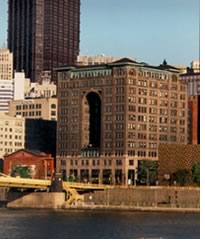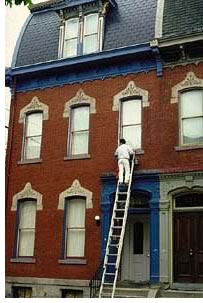

Historic Preservation Advocates Fight Funding Cuts

by
Tracy F. Ostroff
Associate Editor
 Preservation
advocates are urging lawmakers to fund adequately the initiatives they
say bring economic development and tourism dollars, housing options, and
collaborative partnerships to communities nationwide. These initiatives,
one state historian said, serve in many ways as a “teaching laboratory”
for architects.
Preservation
advocates are urging lawmakers to fund adequately the initiatives they
say bring economic development and tourism dollars, housing options, and
collaborative partnerships to communities nationwide. These initiatives,
one state historian said, serve in many ways as a “teaching laboratory”
for architects.
Advocates are asking the federal government to up its investment in the Historic Preservation Fund (HPF) to a total of $100 million. The HPF is a federal grant program widely recognized for catalyzing historic renovation and restoration programs nationwide. It provides matching grants-in-aid to the states, territories, and tribes to assist in their efforts to protect and preserve properties listed in the National Register of Historic Places.
According to figures provided by Preservation Action, an advocacy group for federal legislation to further the impact of historic preservation at the local, state, and national level, HPF funding has dropped 28 percent, from $94 million, between fiscal 2001 and 2003. President Bush’s 2004 budget proposal calls for level funding—or $67 million—for 2004. Specifically, Preservation Action testified earlier this month before a congressional subcommittee requesting more federal dollars for state and tribal historic preservation offices; the Save America’s Treasures Grants; and to assist states to complete and digitize their historic site surveys. Since 1968, more than $1 billion in grant funds have been awarded to 59 states, territories, tribes, local governments, and the National Trust for Historic Preservation.
States fear extra burdens
In an opinion piece in the Wall Street
Journal, National Trust for Historic Preservation President Richard
Moe, Hon. AIA, warns that the White House economic plan “could compromise
one of the nation’s most effective community revitalization tools”
while putting some of the “most vulnerable citizens at risk.”
In what Moe calls the “much-feared Law of Unintended Consequences,”
two tax incentive programs, the Historic Preservation Tax Credit (HPTC)
and the Low-Income Housing Tax Credit, which offer significant tax breaks
for the rehabilitation of income-producing historic buildings and housing,
would compete with more attractive tax-free alternatives proposed in the
president’s economic plan.
 “Compromising
the federal rehab credit will have a significant ‘trickle-down’
effect as well: More than a score of states have enacted their own tax-incentive
programs, most of them intentionally designed to piggyback on HPTC,”
Moe writes.
“Compromising
the federal rehab credit will have a significant ‘trickle-down’
effect as well: More than a score of states have enacted their own tax-incentive
programs, most of them intentionally designed to piggyback on HPTC,”
Moe writes.
In the 2003 appropriations process, state historic preservation officers received $34 million, $5 million less than requested, said Shannon Papin, director of communications and state services at the National Conference of State Historic Preservation Officers. She said that historic preservation officers understand they are part of an “overall budget tightening” and that their programs are not being singled out. Nonetheless, she said, they fear that the reductions mean cuts in grants and staff that will lead to delayed reviews for surveys for historic rehabilitation projects and less money for renovation programs, such as the Texas Courthouse Preservation Program.
Papin, however, did point to some positive trends in funding for historic preservation, including the President Bush’s new Preserve American initiative, announced in March 2003, which the White House developed in cooperation with the Advisory Council on Historic Preservation and the U.S. departments of Interior and Commerce. Through this program, communities can apply to be designated “Preserve America Communities” for linking their “historic assets with efforts to revitalize communities, create jobs, and educate the public.” Funding will derive from the Interior and Commerce departments as well as from Save America Treasures funds.
 James
Malanaphy III, AIA, a state historian in Alaska, said he is anticipating
that the new program will assist preservationists and developers in his
state, where the resources they have are spent on archaeological properties,
such as mining and oil exploration and large transportation projects,
because the state covers so much physical area. Malanaphy pointed out
that many of the “historic” resources in Alaska are fewer
than 100 years old, constituting the state’s “modern frontier
environment.” Through an anomaly in the appropriation model, Alaska
received more money than in the past, he added, but that still was “not
adequate” to pursue a full complement of programs, including public
education and outreach.
James
Malanaphy III, AIA, a state historian in Alaska, said he is anticipating
that the new program will assist preservationists and developers in his
state, where the resources they have are spent on archaeological properties,
such as mining and oil exploration and large transportation projects,
because the state covers so much physical area. Malanaphy pointed out
that many of the “historic” resources in Alaska are fewer
than 100 years old, constituting the state’s “modern frontier
environment.” Through an anomaly in the appropriation model, Alaska
received more money than in the past, he added, but that still was “not
adequate” to pursue a full complement of programs, including public
education and outreach.
Historic preservation advocates hope that their fortunes will improve with the economy and that developers will continue to take advantage of the incentive programs to continue the same type of economic growth that historic rehabilitation has precipitated in places such as Baltimore’s Inner Harbor and main streets across the country. Malanaphy suggested that historic preservation is important because, by revealing the layers of our history, we can “interpret,” through technical information, buildings, and landscapes, our history and how we reflect the culture of our times.
Copyright 2003 The American Institute of Architects.
All rights reserved. Home Page ![]()
![]()
